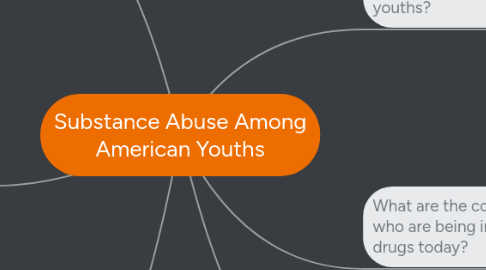
1. Why are teens getting addicted to drugs?
1.1. Peer Pressure and the social context in which young people encounter drugs
1.2. People (adolescents) with associated problems such as psychiatric problems, are more suseptable to drug dependence.
1.3. http://ezproxy.montevallo.edu:2135/ehost/detail?vid=5&hid=8&sid=74713858-a9ae-4fb8-b452-1c3f9fb56a7f%40sessionmgr11&bdata=JnNpdGU9ZWhvc3QtbGl2ZQ%3d%3d#db=funk&AN=DR087700
1.4. What constitutes a youth to be considered 'at risk' to develop a substance abuse issue?
2. Are older generations affecting teens using drugs?
2.1. A variety of components, such as cultural environment, availability, exposure to drug use patterns, and self-perceived needs, contribute to the acquisition of a drug habit.
2.2. Most researchers and clinicians agree that substance use disorders among adolescents share many similarities...The similarities include impairment of these individuals, dysfunctions within the family and social network...
2.2.1. Find examples
2.2.2. Find relevant quotes
2.2.3. References
2.2.3.1. Books
2.2.3.2. News sources
2.2.3.3. Blogs
2.2.3.4. Supporting Data
2.2.3.4.1. Expert reports
2.2.3.4.2. Third party research
2.2.3.4.3. Survey data
2.2.3.4.4. Size of topic
2.2.4. http://digisrv-2.biblio.etc.tu-bs.de:8080/docportal/servlets/MCRFileNodeServlet/DocPortal_derivate_00001904/Monograph156.pdf#page=13
2.3. Studies show that divorce can attribute to risk of adolescent drug abuse. Viewed more as an event/dichotomous state, rather than a complex process in which the changing marital status intervenes with the developmental stages of the youth.
2.3.1. http://www.jstor.org/discover/10.2307/352847?uid=3739520&uid=2&uid=4&uid=3739256&sid=21101526888697
3. What is being and can be done to prevent and treat drug addicted youths?
3.1. Different levels and forms of drug treatment are available at clinics and within the home, or other more intimate environments
3.2. Initial
3.2.1. Period of detoxification meshed with several weeks of initial abstinence that also include counseling sessions 3-5 times a week, that gradually decrease over a period of 12-18 months.
3.2.1.1. Associated underlying issues that pertain to substance abuse are usually addressed at this stage
3.2.1.1.1. http://ezproxy.montevallo.edu:2135/ehost/detail?vid=5&hid=8&sid=74713858-a9ae-4fb8-b452-1c3f9fb56a7f%40sessionmgr11&bdata=JnNpdGU9ZWhvc3QtbGl2ZQ%3d%3d#db=funk&AN=DR087700
3.3. Therapeutic Community
3.3.1. takes place in a residential unit or other controlled environment and involves a collaborative and interdependent situation in which patients are assigned tasks that are essential for keeping the community functioning. Treatment progresses in phases, which are marked by promoting the patient to increasing levels of responsibility for maintaining the residence and the therapeutic environment
3.4. Maintenance
3.4.1. Here, synthetic forms of drugs are used to reduce cravings and therefor reduce chances of relapse
4. What are the most common types of substances being abused by adolescents?
4.1. With the growing popularity of 'raves', more youths are beginning to use 'club' drugs; MDMA, LSD, Ketamine, and GHB (date rape drugs).
4.1.1. http://www.fbi.gov/scams-safety/clubdrugs/clubdrugs
4.2. Marijuana is the most commonly abused illegal substance throughout the country and among all age groups.
4.2.1. Among youths age 12–17, an estimated 9.8 percent were current users of illicit drugs, down from 11.6 percent in 2002.
5. How is adolescent drug use portrayed in the media?
5.1. Media Awareness Project (MAP)
5.1.1. http://www.mapinc.org/find?246
5.2. Television
5.2.1. Drug use on mainstream television usually concludes with negative consequences to said use.
5.2.1.1. http://abcnews.go.com/Health/story?id=116947&page=1#.UMV4yKwhWmk
5.3. Films/Movies
5.3.1. Movies have a tendency to more positively portray drug use.
5.4. One of the most complex social problems facing us today.
5.4.1. http://www.healthypeople.gov/2020/lhi/substanceabuse.aspx
6. What are the consequences of future generations who are being influenced by adolescents abusing drugs today?
6.1. Strong evidence that family influence is one of the strongest predictors of adolescent drug use.
6.1.1. http://baywood.metapress.com/app/home/contribution.asp?referrer=parent&backto=issue,2,5;journal,46,166;linkingpublicationresults,1:300320,1
